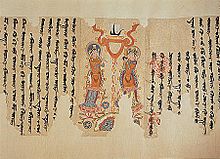Sogdian language
| Sogdian | ||
|---|---|---|
|
Spoken in |
Central Asia ( Sogdia ) | |
| speaker | none ( language extinct ) | |
| Linguistic classification |
|
|
| Official status | ||
| Official language in | leading cultural and commercial language along the historic Silk Road | |
| Language codes | ||
| ISO 639 -2 |
so-called |
|
| ISO 639-3 |
so-called |
|
Sogdian was a widely spoken Central Iranian language . In the course of the Turkish conquest of Central Asia , Sogdian, along with other languages of the Eastern Iranian language family, was replaced by Turkic languages . The urban population adopted the Persian language . Except for the Jaghnobi , which is currently still spoken by a few hunters up in the Jaghnob Valley in Tajikistan , the Sogdian language has become extinct.
Distribution area
It is the best known and most richly documented Eastern Iranian language of the Central Iranian period. It was spoken in Sogdia (Old Persian Sugda , Sogdish Suγd ) with Samarkand as the center. Numerous newly established trading colonies of Sogdian merchants along the Silk Road resulted in Sogdian becoming the general lingua franca of East Turkestan. Despite the wide distribution of Sogdian texts from the motherland between Oxus (Amudarja) and Jaxartes (Syrdarja) to Turfan and Dunhuang, there were hardly any dialect differences, but at most chronological, orthographic or sociolectical divergences.
meaning
Sogdian was one of the most important Middle Iranian languages with an extensive literature that is on a par with Middle Persian and Parthian . It was once the trade language in all of Central Asia ( Transoxania ) and the lingua franca of Chinese and Iranian traders. The language belonged to the northeast branch of the Iranian languages . So far, no evidence of an earlier language level (* Proto / Old Sogdian ) has been found. However, since the area is mentioned in ancient Persian inscriptions, it can be assumed that a separate Sogdish, recognizable as such, existed at least since the dynasty of the Achaemenids (approx. 550 to 323 BC). Sogdian has a more conservative morphology than Middle Persian.
The economic and political importance of the Sogdian language was the guarantee for its survival in the centuries after the conquest of Sogdia by the Muslims in the eighth century AD. Since the earliest New Persian texts were written on Sogdian territory under the Samanids , many Sogdian words found their way into the modern Persian language.
Up until the end of the 10th century there was a bilingual upper class, after which Sogdian had disappeared from the cities and survived the following centuries only in the countryside, where individual elements of the Sogdian culture have been preserved to this day.
An important source are the Sogdian letters found by Sir Aurel Stein in 1907 west of Dunhuang on the Great Wall of China. These late antique texts, written by private individuals, contain important information about the economy along the Silk Road , with the Sogden playing an important role, and also on political events (such as the capture of the Chinese capital Luoyang by Liu Cong in 311 ).
font
An early Sogdian script was found in Sogdia. This script is based on the Aramaic alphabet . The largest part of the text corpus (religious writings, letters, literature and administrative correspondence) has survived in a later Sogdian script, which is also based on the Aramaic alphabet and like the Middle Persian script (Pahlavi script) has many heterograms . Various Sogdian texts, almost exclusively religious writings by Manichaean and Christian authors, were also found in the text corpus of Turfan . The Sogdian script is the direct forerunner of the Uighur script , from which the Mongolian script developed.
Sogdian example text (transliteration): MN sγwδy-k MLK 'δy-w'šty-c' t x'xsrc xwβw 'pšwnw δrwth γ-rβ nm'cyw
Word-for-word translation: From Sogdien's King Dywashtic to Khakhsar's Khuv Afshun, (good) health (and) many obeisances
literature
- Badresaman Gharib: Sogdian Dictionary. Sogdian-Persian-English . Farhangan Publications, Tehran 1995, ISBN 964-5558-06-9
- Nicholas Sims-Williams : Sogdian . In: Rüdiger Schmitt (Ed.): Compendium Linguarum Iranicarum . Reichert, Wiesbaden 1989, ISBN 3-88226-413-6 , pp. 173-192
- Émile Benveniste : Études sogdiennes . Reichert, Wiesbaden 1979, ISBN 3-920153-63-4
Web links
- Sogdian loanwords in Persian . In: Ehsan Yarshater (Ed.): Encyclopædia Iranica (English, including references)
- Sogdian text example
Remarks
- ↑ Étienne de La Vaissière : Sogdian Traders. A history . ( Handbook of Oriental Studies . 8th section: Central Asia , Volume 10) Brill, Leiden / Boston 2005, p. 289
- ^ The Sogdian Ancient Letters (Letters 1–3 and 5 in English translation by Nicholas Sims-Williams).

